LRT may stand for:
LRT may stand for:

Light rail is a form of passenger urban rail transit using rolling stock derived from tram technology while also having some features from heavy rapid transit.
Metro may refer to:
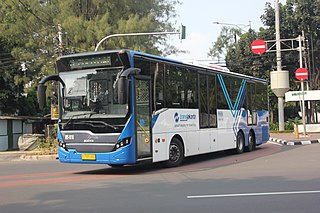
Bus rapid transit (BRT), also referred to as a busway or transitway, is a trolleybus, electric bus and public transport bus service system designed to have much more capacity, reliability, and other quality features than a conventional bus system. Typically, a BRT system includes roadways that are dedicated to buses, and gives priority to buses at intersections where buses may interact with other traffic; alongside design features to reduce delays caused by passengers boarding or leaving buses, or paying fares. BRT aims to combine the capacity and speed of a light rail transit (LRT) or mass rapid transit (MRT) system with the flexibility, lower cost and simplicity of a bus system.
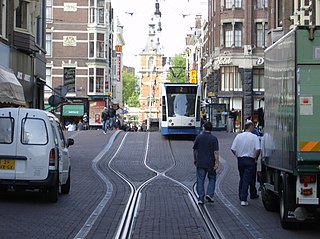
In urban planning, transit-oriented development (TOD) is a type of urban development that maximizes the amount of residential, business and leisure space within walking distance of public transport. It promotes a symbiotic relationship between dense, compact urban form and public transport use. In doing so, TOD aims to increase public transport ridership by reducing the use of private cars and by promoting sustainable urban growth.
University station may refer to any of the following:

An elevated railway or elevated train is a railway with the tracks above street level on a viaduct or other elevated structure. The railway may be broad-gauge, standard-gauge or narrow-gauge railway, light rail, monorail, or a suspension railway. Elevated railways are normally found in urban areas where there would otherwise be multiple level crossings. Usually, the tracks of elevated railways that run on steel viaducts can be seen from street level.

The Light Rail Transit system, locally known by the initialism LRT, are a series of localised automated guideway transit (AGT) systems in Singapore which acts as feeder services to the heavy rail Mass Rapid Transit (MRT), and together forms the core of the country's rail transport services. The first LRT line was opened in 1999 and the system has since expanded to two lines, each serving three new towns, namely Bukit Panjang, Sengkang and Punggol, with a total system length of approximately 30 km (19 mi). Trains on these lines have at least one station interchange link to the MRT.
Various terms are used for passenger railway lines and equipment; the usage of these terms differs substantially between areas:
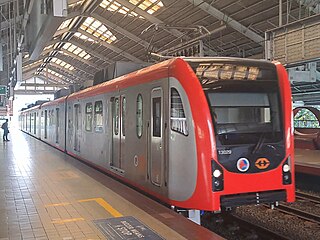
The Manila Light Rail Transit System, commonly known as the LRT, is an urban rail transit system that primarily serves Metro Manila, Philippines. Although categorized as a light rail system because it originally used light rail vehicles, it presently has characteristics of a rapid transit system, such as high passenger throughput, exclusive right-of-way, and later use of full metro rolling stock. The LRT is jointly-operated by the Light Rail Transit Authority (LRTA), a government corporation attached to the Department of Transportation (DOTr), and the Light Rail Manila Corporation (LRMC). Along with the Manila Metro Rail Transit System and the Metro Commuter Line of the Philippine National Railways, the system makes up Metro Manila's rail infrastructure.

The Light Rail Transit Line 2, also known as LRT Line 2, LRT-2, or Megatren, is a rapid transit line in Metro Manila in the Philippines owned and operated by the Light Rail Transit Authority (LRTA). The line generally runs in an east–west direction between Recto in Manila and Antipolo. The line is officially referred to as the Purple Line.

Edmonton Light Rail Transit, commonly referred to as the LRT, is a light rail system in Edmonton, Alberta. Part of the Edmonton Transit Service (ETS), the system has 29 stations on three lines and 37.4 km (23.2 mi) of track. Much of the system has a dedicated right-of-way, while in the downtown area, vehicles run underground. This subway-surface alignment is known as semi-metro. As of 2018, it was number seven on a list of the busiest light rail transit systems in North America, with over 113,000 daily weekday riders.

Light rail is a commonly used mode of public transit in North America. The term light rail was coined in 1972 by the Urban Mass Transportation Administration to describe new streetcar transformations which were taking place in Europe and the United States. The Germans used the term Stadtbahn, which is the predecessor to North American light rail, to describe the concept, and many in UMTA wanted to adopt the direct translation, which is city rail. However, in its reports, UMTA finally adopted the term light rail instead.

A medium-capacity system (MCS), also known as light rapid transit or light metro, is a rail transport system with a capacity greater than light rail, but less than typical heavy-rail rapid transit. MCS trains are usually 1 to 4 cars. Most medium-capacity rail systems are automated or use light-rail type vehicles.

Ion, stylized as ION, is an integrated public transportation network in the Regional Municipality of Waterloo in Ontario, Canada. It is operated by Keolis and is part of the Grand River Transit (GRT) system, partially replacing GRT's Route 200 iXpress bus service. The section of the bus route serving Cambridge has been renamed "Ion Bus", and renumbered as 302. The first phase commenced operations on June 21, 2019, between the north end of Waterloo and the south end of Kitchener. A future extension of light rail to the downtown Galt area of Cambridge is planned but construction may not begin on that line until 2028. In 2023, Ion LRT had an annual ridership of 4.3 million, and a daily ridership of 11,780.

Rapid transit or mass rapid transit (MRT) or heavy rail, commonly referred to as metro, is a type of high-capacity public transport that is generally built in urban areas. A grade separated rapid transit line below ground surface through a tunnel can be regionally called a subway, tube, metro or underground. They are sometimes grade-separated on elevated railways, in which case some are referred to as el trains – short for "elevated" – or skytrains. Rapid transit systems are railways, usually electric, that unlike buses or trams operate on an exclusive right-of-way, which cannot be accessed by pedestrians or other vehicles.
The Light Rail Transit Line 6 is a proposed rapid transit system in Cavite, Philippines. There have been two proposals for the line, with the first one shelved immediately in 2018. Another proposal emerged in 2017 and is currently under review by the National Economic and Development Authority (NEDA).

The Jabodebek LRT, formerly known as Greater Jakarta LRT is a light rapid transit system in Greater Jakarta, the capital city of Indonesia, as well as the adjacent areas of West Java, within the Jakarta Metropolitan area. It was implemented by the central government, and operated by Kereta Api Indonesia (KAI), the system connects the Jakarta city center with suburbs in Greater Jakarta such as Bogor, Depok and Bekasi, hence its acronym Jabodebek.

The South Sumatra Light Rapid Transit, colloquially known as LRT Palembang or Palembang LRT, is an operational light rapid transit system in Palembang, South Sumatra, Indonesia which connects Sultan Mahmud Badaruddin II International Airport and Jakabaring Sport City. It is the first practical modern light rapid system to operate in Indonesia. It was also the first rail line as a rapid transit system in the country.
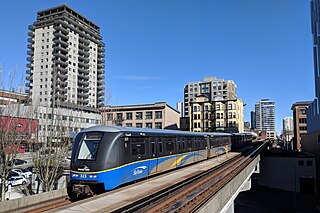
Urban rail transit in Canada encompasses a broad range of rail mass transit systems, including commuter rail, rapid transit, light rail, and streetcar systems.
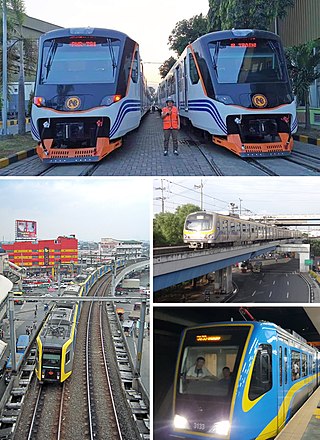
Rail transportation in the Greater Manila Area is a major part of the transportation system in Metro Manila and its surrounding areas. The railway network, collectively known as the Greater Capital Region Railway System, consists of the Manila Light Rail Transit System (LRT), Manila Metro Rail Transit System (MRT), and Philippine National Railways lines within the region.